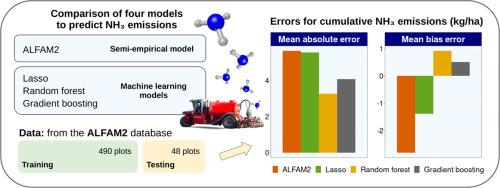Machine learning for ammonia volatilization prediction and slurry application management
IF 6.3
2区 环境科学与生态学
Q1 ENVIRONMENTAL SCIENCES
引用次数: 0
Abstract
Anthropogenic ammonia emissions primarily originate from agriculture, especially field fertilization. These emissions represent nitrogen loss for farmers and contribute to air pollution, posing risks to human health and the environment. Estimating ammonia emissions is crucial for national inventories and policy-making. Various models exist for predicting emissions, including mechanistic, empirical, and semi-empirical approaches. While machine learning (ML) is widely used in environmental science, its application to ammonia emissions remains limited. In this study, we used 5939 ammonia emission data from 538 trials, extracted from the ALFAM2 database, to train three machine learning methods - random forest, gradient boosting, and lasso - for predicting cumulative ammonia emissions 72 h after manure application. These methods were compared to the semi-empirical ALFAM2 model using an independent test dataset. Random forest (RMSE = 4.51, r = 0.94, MAE = 3.28, Bias = 0.92) and gradient boosting (RMSE = 6.19, r = 0.89, MAE = 4.10, Bias = 0.51) showed the best performance, while the lasso log-linear model (RMSE = 7.30, r = 0.84, MAE = 5.57, Bias = -1.38) performed worst. Both random forest and gradient boosting outperformed the semi-empirical ALFAM2 model, which showed performance comparable to the lasso model. We then used these models and the ALFAM2 model to compare five slurry management techniques, varying in application method (trailing hoses, trailing shoes, and open slot) and post-application incorporation, across 128 scenarios with different manure types and weather conditions. Compared to broadcast application, alternative techniques reduced emissions by a median of -13.6 % to -61.7 %. This study highlights the promise of ML models in assessing ammonia emission reduction methods, while emphasizing the importance of evaluating model sensitivity to algorithm choice.

氨挥发预测和浆料应用管理的机器学习
人为排放的氨主要来自农业,特别是田间施肥。这些排放对农民造成氮损失,并造成空气污染,对人类健康和环境构成风险。估算氨排放对国家清单和决策至关重要。存在各种预测排放的模型,包括机械方法、经验方法和半经验方法。虽然机器学习(ML)在环境科学中得到了广泛的应用,但它在氨排放方面的应用仍然有限。在这项研究中,我们使用从ALFAM2数据库中提取的538个试验的5939个氨排放数据来训练三种机器学习方法——随机森林、梯度增强和套索——来预测施肥后72小时的累积氨排放。使用独立的测试数据集将这些方法与半经验ALFAM2模型进行比较。随机森林模型(RMSE = 4.51, r = 0.94, MAE = 3.28, Bias = 0.92)和梯度增强模型(RMSE = 6.19, r = 0.89, MAE = 4.10, Bias = 0.51)表现最佳,而lasso对数线性模型(RMSE = 7.30, r = 0.84, MAE = 5.57, Bias = -1.38)表现最差。随机森林和梯度增强都优于半经验ALFAM2模型,其性能与lasso模型相当。然后,我们使用这些模型和ALFAM2模型,在128种不同肥料类型和天气条件的情况下,比较了5种浆液管理技术,这些技术在施用方法(拖尾软管、拖尾鞋和开槽)和施用后结合方面各不相同。与广播应用相比,替代技术减少排放的中位数为- 13.6%至- 61.7%。本研究强调了ML模型在评估氨减排方法方面的前景,同时强调了评估模型对算法选择敏感性的重要性。
本文章由计算机程序翻译,如有差异,请以英文原文为准。
求助全文
约1分钟内获得全文
求助全文
来源期刊

Journal of Environmental Sciences-china
环境科学-环境科学
CiteScore
13.70
自引率
0.00%
发文量
6354
审稿时长
2.6 months
期刊介绍:
The Journal of Environmental Sciences is an international journal started in 1989. The journal is devoted to publish original, peer-reviewed research papers on main aspects of environmental sciences, such as environmental chemistry, environmental biology, ecology, geosciences and environmental physics. Appropriate subjects include basic and applied research on atmospheric, terrestrial and aquatic environments, pollution control and abatement technology, conservation of natural resources, environmental health and toxicology. Announcements of international environmental science meetings and other recent information are also included.
 求助内容:
求助内容: 应助结果提醒方式:
应助结果提醒方式:


